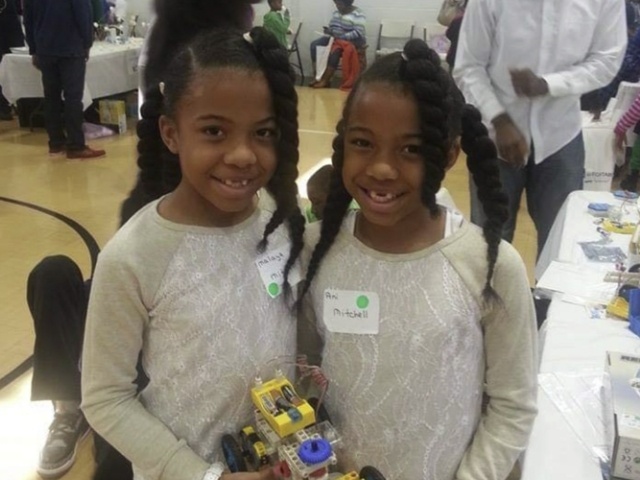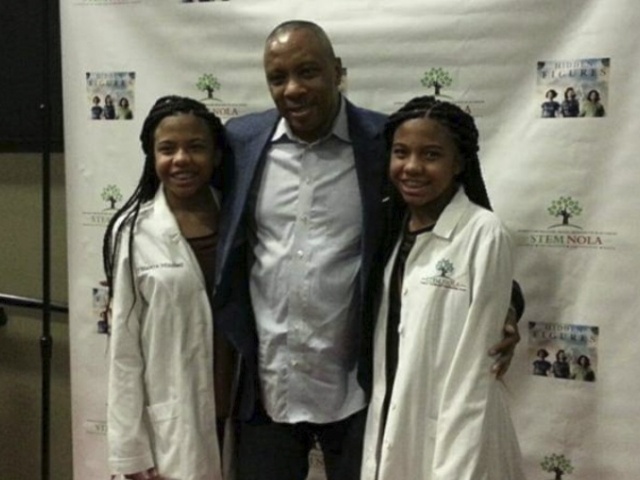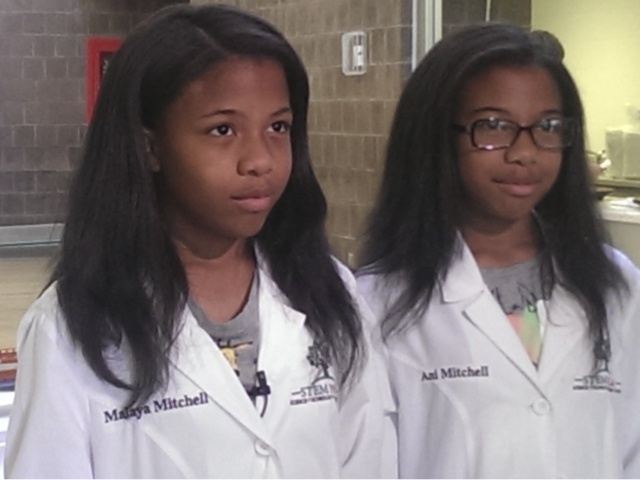
Young Malaya and Ani Mitchell begin their STEM journey with STEM NOLA

STEM Global Action Founder Dr. Calvin Mackie with the amazing Mitchell twins

Malaya and Ani Mitchell are positioned to be future STEM leaders
At nine years old, Malaya Mitchell was spending her Saturday morning at a STEM NOLA event. Here she was at an inner-city, community center, dissecting a sheep heart.
“It didn’t smell too nice,” she recalls, “but it was actually pretty fun because their hearts are the best anatomical equivalent to our hearts. I was able to see what a real human heart would look like. It was really cool. Cutting it open, seeing all the parts and then just dealing with the tools.”
The experience eight years ago made an impression on young Malaya. She decided not only that she wants to be a medical doctor, but a surgeon.
For her twin sister, Ani, the STEM Saturday events moved her in a different direction. As long as Ani can remember, she liked building things. On Saturdays, she would come home from STEM NOLA with self-made boats, cars or robots. “Building stuff, it’s just so fun to me,” Ani says, noting that her career goal is to be an environmental engineer.
Malaya and Ani, 17, are examples of young lives shaped by participation in the STEM NOLA education programs. Children and adolescents, especially those from communities of color, don’t get enough exposure to a wide range of career opportunities. STEM NOLA, an affiliate of STEM Global Action, is filling in that void by providing hands-on experiences in science, technology, engineering and math (STEM) subjects. Furthermore, it is also providing the young participants rare opportunities to showcase their talents and brilliance, traits too often overlooked or never displayed during daily struggles to survive in troubled communities.
These STEM programs are fueling hope for the future. Participants, like Malaya and Ani, can emerge as leaders in their STEM fields, and in so doing, be role models for those who follow in their footsteps. The twins talk about the critical role that their STEM NOLA experiences played in shaping their lives, and their futures.
They even remember their first event. Their grandmother had seen STEM NOLA on the news and told their mother to get the girls involved.
“It was a STEM Fest event, so we got to see everything,” says Malaya. “And most of the time we spent at this one station where we got to build this robot. And after that it we were stuck. It had a motor and batteries and a remote control. We also built our own remote-control car by the end of the event. And after that, attending the STEM Fest was our Christmas gift every year because we wanted to build all the other stuff in the book.”
A few years later, when the girls were 13, their STEM NOLA engagement grew when they transitioned from students to volunteers, who worked with the younger children.
“Being a volunteer was even more fun than the learning part, because I got to show the kids how they can use their imagination to make fascinating things, and how cool that is,” says Malaya. “When I did my builds, I didn’t stick to the book, I would rig them up. I would put two propellers on my boat so it was faster than everyone else’s or if we did catapults, I would do two spoons instead of one so I could launch more marshmallows. I was showing the younger kids how to use their imagination to make their stuff better than the standard builds.”
Moreover, the STEM NOLA experience helped Malaya overcome her hesitancy in speaking before large audiences, after all she got practice appearing in local news segments promoting STEM NOLA programs and activities. It also helped build her confidence that she could become a doctor.
“I saw and met Black doctors,” she says. “They had people who looked like me and people who had the types of careers that I was interested in. I was able to speak with them and learn what it was really like to be in that career. It was fascinating. They used to talk about what it was like to be a Black doctor and their journey. They all talked about their degrees. And it was so fascinating to see how educated they were. I was impressed that they would take a random Saturday out of their lives to come talk to us.”
Ani, agreed, saying, “I got to meet people that built rocket ships and astronauts, doctors, engineers, people that helped build our levees. Stuff like that. It’s just really cool.”
Ani, meanwhile, is wired a bit differently than Malaya. Since the sixth grade, when she first learned of climate change, the ozone layer and food deserts, she has wanted to find and build solutions. “Even though it’s cliche to say that, ‘Oh, I want to feed the children of Africa.’ I want to design the systems that bring them water. I want to help people, but I want to help people in my way, not by being a humanitarian, but from being an environmental engineer. Think of it as being a bridge, the structure that is needed so humanitarians can help the people.”
The environmental challenges confronting New Orleans have also shaped her career path. “I feel like its impacted me more in recent years, Ani says. “The effects of the hurricanes have played a role. I’ve done more research. Cities are bowls and the water goes to the middle. Seeing that in my community just makes me want to do it even more because I’ll be actually helping people that I know and love and essentially saving my city.”
This summer, the twins stepped up again at STEM NOLA as the high school seniors were essentially instructors at summer school classes.
The girls, who expect to attend college in the same area, perhaps Texas, don’t think it is unusual that one wants to be a doctor and the other an engineer. “They are different STEM professions, but both like helping people,” says Ani.” We’ve always enjoyed helping people and teaching people. They are on different sides of STEM, but the common denominator is desire to help people. That is what we believe in.”
